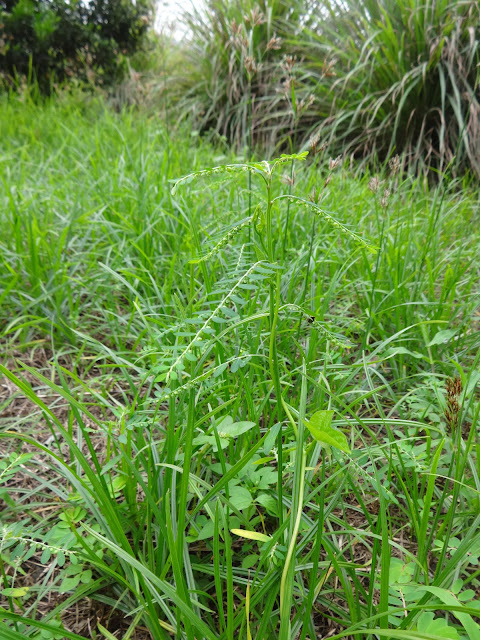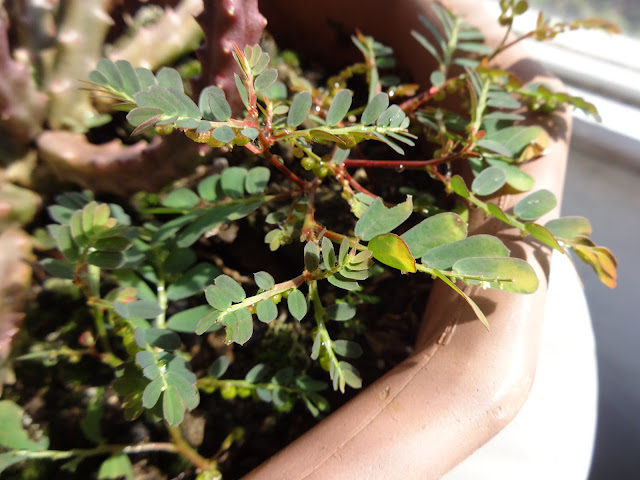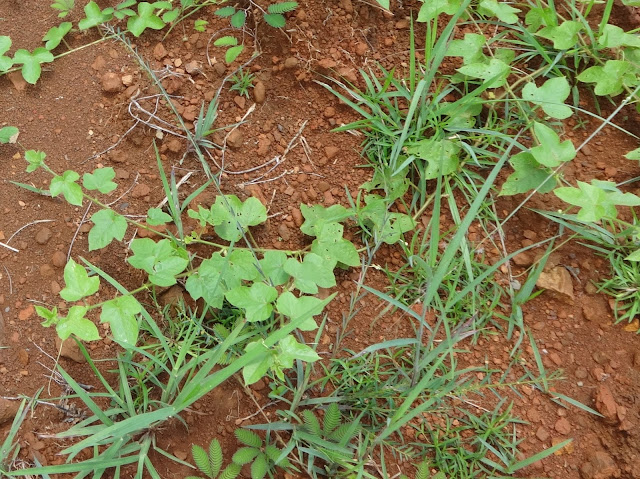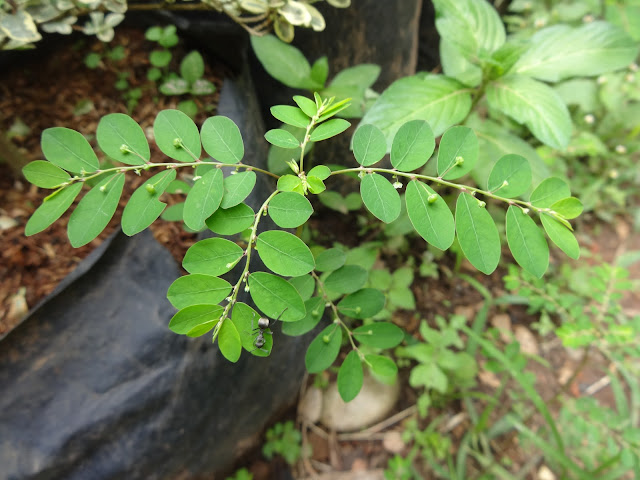PLANT PROFILE
Phyllanthus niruri is a tropical annual herb, it is a tiny plant with a huge medicinal meaning. It has been used as a cure since ancient times in Ayurveda, Siddha, Unani and other traditional systems of medicine. And nowadays in many tropical and subtropical countries it is very popular not only as a folk remedy or official herbal product, but also as an ingredient in pharmaceutical drugs prescribed by orthodox medicine practitioners.
It is mostly famous for its effectiveness in curing hepatitis, jaundice, kidney stones and malaria but full list of its medicinal uses is impressively long. And even longer is the list of scientific medicinal and pharmacological studies on this herb, conducted in many countries around the world.
Phyllanthus niruri has many botanical synonyms that are out of use nowadays, but two - Phyllanthus urinaria and Phyllanthus amarus are not only frequently used, but also distinguished by some botanist as a separate species (some says that P. amarus and P. urinaria comes from tropical Asia while P. niruri originates from tropical America, but has no characteristic differencess except being '' slightly different in size ''). Much less often you can find names Phyllanthus fraternus and Phyllanthus debilis, both are also used as synonymes for P. niruri as well as by some recognised as seperate species. And there are closely related species, with similar structure, grow habit and chemical substances composition to P. niruri, like Phyllanthus virgatus - syn. Phyllanthus simplex, Phyllanthus sellowianus, Phyllanthus corcovadensis, Phyllanthus tenellus, Phyllanthus caroliniensis, Phyllanthus watsonii, Phyllanthus rheedii and Phyllanthus maderaspatensis. And those species usually share the same common names and medicinal uses as Phyllanthus niruri.
English common names for P. niruri include Stone-breaker, Chamberbitters, Leafflower, Shatterstone, Gripeweed, Seed-under-leaf and Gale of the wind. Here are some of its names in other languages : Chanca Piedra, Flor escondida (Spanish), Quebra Pedra, Arranca Pedras, Erva Pombinha (Portugese-Brasil), Bhumlyamalaki, Tamalaki, Bahupatri, Bhudatra, Ksetramali, Suksmaphala (Sanskrit), Bhumi Amla, Bhumiamalaki, Bhuiavala, Bhuiamla, Jaramla, Niruri (Hindi), Keelanelli, Kizhar Nelli, Keezhkainelli (Tamil), Bhuiamla (Bengali), Nellaneeli (Kannada), Kiruthanelli (Malayalam), Nelaustrika (Telugu), Pitawakka (Sri Lanka - Sinhala), Daun Meniran, Memeniram, Gendong Anak, Dukung Dukung Anak (Indonesia), Pokok Dukung Anak, Amin Buah, Keman Jolok, Rami Buah, Turi Hutan (Malaysia), Ya Tai Bai (Thailand), Diep ha chau (Vietnam), Zhen Chu Cao, Ye Xia Zhu, Be Bei Cai, Xiao Fan Hun (Chinese), Ko-makansuo, Komikanso (Japan), Bhumyalaki, Bhui Amala (Nepal), Niruri (Pakistan), Yerba de Quininic (Puerto-Rico), Shka-nin-du (Mexico), Yerba de la Nina (Cuba), Des So, Derriere Dos, Grains Sur Dos (Haiti), Doubling Plant, Dobisowo, Ehin Olobe, Ngwu, Buchi Oro (Nigeria), Elrageig (Sudan), Jar amla (Fiji), Mapatan, Sasi (Papun-New Guinea), Quinine Creole, Petit Tamarin Rouge; Phyllanthe diuretique (French), Sampa-sampalukan (the Philippines -Tagalog), Malakinum-kirum (Visayan), Talikod, Taltalikod (Illocano), Ngingihel (Ifugao).

CULTIVATION AND HARVESTING
Phyllanthus niruri is a annual plant growing in tropical climat regions around the world, and some subtropical too. It usually grows less than 20cm high, but sometimes it reach even 70cm (especially in cultivation, with lots of nutrients and water provided). As a plant from genus Phyllanthus it is characteristic for its flowers that turns into fruits, growing on downside of its compound leaves. It also has a white milky sap. As an annual herbacous plant Phyllanthus niruri is hard to classify as a species. Its morphological variations due to different environmental conditions and genetic ancestry, leads to controversy about what is the real Phyllanthus niruri. Many scientists recognise plants labeled by others as P. niruri, as different species like Phyllanthus amarus, P. urinaria, P. debilis, P. fraternus and even other. But crosspolination makes this highly debatable distinction work really hard to make.
Phyllanthus niruri likes worm, humid, half shaded, moist soil areas, but can be found also in dryier, sunny low-grass lands, on both low and even very high elevations above sea level. It tolerate both acidic and alkaline pH, and also saline and infertile soils, but neutral or slightly alkaline pH is proved to be best for its growth. It can be even found in cities, growing straight from tiny cracks in concrete. It often grows wild on cultivated fields, among crops like maize, cassava, okra and soya, and some farmers are using Niruri's potential as an intercrop. Others are making plain Phyllantus plantations, yet this herb is still mostly gathered from the wild. The plant is resistant to heat and scourching sun (which cause its leaves and stems or seeds turning red or brownish), but die easily due to longer drought or any frost. It produces lots of tiny seeds and can became a bit invasive weed. The seeds require light for germination, and best temperatures are between 25-35'C. They can remain dormant for around 6 months, and germinate usually after strong rains.
Phyllanthus niruri is usually harvested by uprooting the whole plant, and hanged do dry after washing the roots, as all its parts including roots are valuable herbal material.
Apart from medicinal use decoction from the stem and leaves of P. niruri is used to dye cotton threads black, and sometimes used in place of ink. Alcoholic extracts of P. niruri showed significant growth inhibition of Pythium debaryanum mould that is plant pathogen.
 MEDICINAL USES
MEDICINAL USESPhyllanthus niruri is a herb that plays huge significance in many tropical and subtropical countries. It has a long tradition of wide use in traditional medicine systems of India, Sri Lanka, Pakistan, China, Malaysia, Indonesia, Thailand, Nigeria, Brazil and many other. In india oldest record of it's medicinal use had been found in texts of Caraka Samhita, which can be as old as from fourth century BCE, but it is hard now to date precisely when it's original version was created. It was mentioned there as an ingredient of multiherb preparation for jaundice. Nowadays popularity of this herb in many cultures so distant from each other, has mainly the same cause, it is best known for its ability to cure hepatitis and other liver diseases, remove and prevent kidney stones formation, and effectivenss against malaria and other febrile diseases, as well as for digestive cure. Since mid-1960s a huge number of scientific studies has been made around the world, confirming many of medicinal properties and discovering chemical composition of Phyllanthus niruri. Positive resoults of scientific researches bring this plant high recognition not only in modern herbalism, but in some countries even in orthodox medicine, and paved its way to pharmacies. This herb is available on the market in form of whole dried herb, tea sachettes, powder, capsules, tablets, and liquid alcoholic and non-alcoholic extracts. And is still commonly gathered from wild, but more and more plantations is now established. Whole fresh plants are used in the same way as dried ones.
Phyllanthus niruri contain : lignans (phyllanthin, hypophyllanthin, nyrphylline, nirtetralin, niranthin, phyltetralin, phyllnirurin ), tannins (phyllanthusin D, amariin, amarulone, amarinic acid), ellagitannins (repandusinic acid, geraniin, corilagin), flavonoids (quercertin, astralgin, quercertrin, isoquercitrin and rutin), flavonols (quercetin), sterols (beta-sitosterol), alkaloids (ent-norsecurinine, sobubbialine, epibubbialine, sobubbialine, epibubbialine, diarylbutane, nyrphyllin, nirurine, phyllochrysine), saponins, leucodelphins, ellagic acid, gallic acid, calcium oxalate, phyltetralin, diarylbutane, glycosides, phenylpropanoids, common lipids, astragalin, carboxylic acids (brevifolin), cymene, gallocatechins, lintetralins, methyl salicylate, niruretin, niruriside, repandusinic acids, triacontanal, tricontanol. triterpenes (lupeol, phyllanthol, phyllanthenol) and amarinic acid among others. It also contain high amounts of potassium, manganese, copper and zinc.
Hepatitis B DNAp inhibition tests has showed that Phyllanthus amarus plants that had grown in higher temperatures are stronger in inhibition effect. That information confirmed my empirical knowledge, as I've noticed that Phyllanthus plants taste generally more bitter in hotter months than in colder one. And the most abundant medicinally active principles in this plant are bitters. I've also noticed that leaves with flowers are more bitter than leaves with fruits/seeds. It also has been found that roots are the most potent part of Phyllanthus niruri in inhibition of DNAp of hepatitis B.
Apart from being bitter this herb is described as acrid, sour and cooling in action. In terms of Ayurveda system of medicine it destroys aggravations of pitta and prameha, correcting any obstructions in the urinary flow, quietens the thirst and any burning sensations. It is also belived to promotes vāta and being beneficial against coughs, raktapitta (plethora), vitiations of kapha and jaundice, and to cure poisoning.
In Western Herbalism terms Phyllanthus niruri medicinal actions are described as : astringent, stomachic, carminative, laxative, cholagogue, hepatoprotective, antihepatotoxic (liver detoxifier), hepatotonic and general tonic, blood cleaning, chemoprotective, antidiarrhoeal, antibacterial, antifungal, antiviral, anti-inflammatory, antiplasmodial, febrifuge, antiseptic, antiulcerous, diuretic, antioedematogenic, antilithic (expels stones), nephroprotective, uterine relaxant, emmenagogue, menstrual stimulant, expectorant, galactagogue, anticancer (cytotoxic, antinociceptive, antimutagenic), immunomodulatory, hypoglycemic, antidiabetic, hypocholesterolemic (lowers cholesterol), antihyperlipidemic, hypotensive (lowers blood pressure), vermifuge (expels worms), antioxidant, anodyne, pain-relieving, antiallodynic, antispasmodic, smooth muscle relaxant, contraceptive, antihyperlipidemic, alexipharmic - antidote, antianemic, very strong tea from leaves can be emetic.
Phyllanthus niruri is often simply eaten raw, whole plants with roots are commonly used fresh or dried to make decoctions and infusions, or sometimes alcoholic tinctures. Most of healing chemical compounds in this herb are completely water soluble, but some of it such as sterols, are fragile and can be destroyed by alcohol. Dried plants are also taken in form of powder, capsules or tablets, to cure many different diseases like :
Stomach and bowels complains - this herb is known to bring relief of many ailments of digestive system, thanks to its tonic, antimicrobial action and bile stimulation. It is used to treat infections, dysentery (including amoebic dysentery), cholera, typhoid, diarrhoea, inflammations, rectitis, appendicitis, tropical sprue, colic, constipation, intestinal gas, stomachaches, indigestion, anorexia, anemia and abdomen tumors. Studies has proved that P. niruri inhibit growth of pathogens like Heliobacter pylori without affecting beneficial lactic acid bacteria. Although diarrhoea is sometimes noted as a side effect of consuming big quantities of this herb, it is generally atributed to its laxative properties, which is consider to be rather mild.
Hypertension and tachycardia - Indian researchers gave patients with high blood pressure P. niruri leaf powder in capsules and reported a significant reduction in systolic blood pressure, a significant increase in urine volume and sodium excretion.
Kidney stones - Phyllanthus niruri has a high reputation as a herb effective in removing kidney and bladder stones, as well as preventing it (inhibit the formation of calcium oxalate crystals). One of the most popular worldwide common names for this herb are Chanca Piedra and Quebra Pedra, which means Stone Breaker in Spanish and Portugese. It is usually taken in form of tea, and its effectiveness is attributed to its diuretic, but also antispasmodic and smooth muscle relaxant properties - "smooth muscle relaxation within the urinary or biliary tract probably facilitates the expulsion of kidney or bladder calculi." - researchers says. Although during actual process of stones elimination some patients experience stomach cramps. But the herb's analgesic action helps this process to be generally painless. German doctor Wolfram Wiemann found P. niruri to be successful in eliminating stones within a week or two, in 94% of over 100 of his patients treated for kidney stones. However this herb is recommended for renal lithiasis when stones are rather small but contraindicated for large stones. Chanca Piedra is also used in cases of gallstones, as it increase bile acid secretion in the gallbladder and significantly lowers blood cholesterol and triglyceride levels. Standard dose of dried Phyllanthus niruri for adults is 3g per cup of water, 2 or 3 times a day.
Other urinary disorders - P. niruri infusions are also commonly drunk to cure many other problems of kidneys and urinary tract such as infections, kidney and bladder pain, kidney colic, spasms, albuminuria and outflow of urine. This herb tone, balance, strengthen, detoxify and protect the kidneys, increase urination and also removes burning associated with its flow. Normalize high levels of urinary calcium, reduce excess of uric acid in blood by increasing its excretion and significant increase sodium excretion. P. niruri is a powerfull diuretic herb (probably due to its high potassium content), and therefore it is usefull in treatment of water retention related diseases like edema, gout and anuria. In France it is an ingredient of diuretic pharmaceutical product called Pilosuryl, in India a tablets of the herb are sold as a diuretic.
Women's problems - Phyllanthus niruri is commonly taken to treat leucorrhea, blennorrhagia, dysmenorrhea and menorrhagia. In India squeezed juice with added pepper powder is consumed daily to relieve the menstrual pains. Decoctions and infusions are given to women in cases of difficult childbirth to facilitate labour, after childbirth or miscarriage (to bring relief to painful womb and treat colic as a uterine muscles relaxant, and to prevent infections), or as an emmanogogue to stimulate menstruation. Pounded leaves are applied to the head after childbirth for vertigo. P. niruri has antifertality effect on females and large doses cause abortion, therefore it should not be used during pregnancy. The plant turned into paste is prepared as a vaginal suppository to induce menstruation. Paste from the whole fresh plant is applied externally to reduce morbid swellings of the breasts. The herb is also taken oraly to treat lack of milk production.
Babies and children maladies - decoctions are given to infants and children for coughs. The young leaves are given to children as a treatment for coughs and hiccups. In Malaysia P. niruri is boiled in goat's milk that is given to children and babies to cure jaundice. The tribals of Chotanagpur, India use the root as a mild sedative to get small children to sleep, and the juice from the leaves is given in coconut milk as an appetizer to children. A little of the plant's juice on a bit of cloth may be used to clean a child's tongue. The plant is mashed into paste and administered by enema to infants as an antidote to poison. Decoction of dried entire plant is used as a bath for newborns as antiseptic for skin.
Fevers - decoction from the whole P. niruri plant or paste from its tender leaves mixed with black pepper, is given as a cure for malarial fever (it is said that after administration of this herb, the stools become normal and sweating commences. The patient secures sleep. Any enlargement of liver and spleen, which often accompanies longstanding fever, subsides and slowly the incidence of intermittent attacks stops.), and all other intermittent fevers. In Paraguay Phyllanthus niruri is used mainly to reduce fever and is sometimes called Poor Man's Quinine, but in Indonesia some people say that it is better for malaria treatment than quinine. Decoctions of the herb are used in baths for treatment of malaria and other fevers.
Bacterial infections - the plant is taken orally in all different forms to fight many different types of bacterial infections of different organs, including : colds, dysentery, cholera, typhoid fever, tuberculosis, leprosy, gonorrhea and syphilis. The herb has been proved in tests to be effective against Micrococcus pyrogenes, Escherichia coli, Staphylococcus and Pasteurella bacteria. Researchers have suggested that it could be effective in treatment of Lyme’s Disease, as it is caused by a spirochete and P. niruri is traditionally used for syphilis, which is also caused by type of spirochete.
Viral infections - this herb has been proved effective against hepatitis A, B and C type virus, dengue virus, herpes and flu. Scientists says that this plant shows signs of being anti-HIV (cells treated with P. niruri extracts were reduced in toxicity, the extract provided considerable protection from HIV destroying the cell, simple water extract of P. niruri inhibited HIV-1 reverse transcriptase necessary for many types of viruses to grow, German research organization published their study on Chanca Piedra and its application with HIV therapy reporting a 70-75% inhibition of virus), they also says that it has potential to treat such retroviruses as sarcoma and leukemia viruses.
Pain - decoctions of whole plants of P. niruri are used for relieving pains such as migraines, joint aches, costal pains and allodynia. This herb has been proved to be especially effective in treatment of inflammatory pains.
Tumors - several studies indicated that the plant has a better ability to prevent and slow down the growth of tumors, rather than a direct toxic effect or ability to kill cancer cells. P. niruri stops or inhibit cells from mutating under exposure to damaging chemicals or radiation, lower tumor incidence, levels of carcinogen-metabolizing enzymes, levels of liver cancer markers, and liver injury markers.
Phyllanthus niruri is also taken as a treatment for asthma and bronchitis, it reduces spasms, and leaves are chewed to stop hiccoughs. This herb has also reputation to puryfy the blood, lowers cholesterol and expels worms.
Phyllanthus niruri has also wide range of external uses :
- the fresh sap from Phyllanthhus niruri is mixed with oil (castor oil in India) and applied to the eyes. It is useful against inflamed eyes and conjunctivitis
- the plant sap is applied to treat bruises, wounds, ulcers, chronic skin diseases. to maturate furuncles and abscesses, it is also used on tumors
- the sap is used by ear-instillation for otitis
Phyllanthus niruri is also taken as a treatment for asthma and bronchitis, it reduces spasms, and leaves are chewed to stop hiccoughs. This herb has also reputation to puryfy the blood, lowers cholesterol and expels worms.
Phyllanthus niruri has also wide range of external uses :
- the fresh sap from Phyllanthhus niruri is mixed with oil (castor oil in India) and applied to the eyes. It is useful against inflamed eyes and conjunctivitis
- the plant sap is applied to treat bruises, wounds, ulcers, chronic skin diseases. to maturate furuncles and abscesses, it is also used on tumors
- the sap is used by ear-instillation for otitis
- poultice made from crushed leaves is applied on bruises, wounds (sometimes mixed with turmeric), inflammations, aberrations, ringworms, psoriasis, eczema, edematous swellings, warts, ulcers and scabbies. P. niruri leaf paste can be used on skin to cure white spots on skin and jaundice, it also reduce itching. The paste is applied externally as an antidote against snake bite.
- decoctions are used for baths during malaria and other fevers and as a skin antiseptic
Contraindications for use of Phyllanthus niruri :
P. niruri is known to be generally safe herb not causing any side effects, nevertheless due to its hypotensive and hypoglycemic effects, people with heart condition, hypoglycemia or diabetics taking medications, should consult their doctors before taking this herb. It is considered to be abortive in high dosages, therefore it is contraindicated during pregnancy and for women seeking pregnancy. Consumption of big ammounts of Phyllanthus niruri is causing diarrhea.

PHYLLANTHUS VIRGATUS syn. PHYLLANTHUS SIMPLEX
PHYLLANTHUS CORCOVADENSIS
Sources
'' Medicinal Plants of the Philippines '' - dr. Eduardo Quisumbing, Katha Publishing 1978
'' Honoring Nature's Healers: Bioregional Ethnobotanical Study of Wild Medicinal Plants of Kathleen, FL in the Greater Green Swamp '' - Patty Morris, Lulu.com 2015
'' Plants and Health '' - A. C. Sas, Eastern Publishing Association 1990
'' Jamu: Ancient Indonesian Art of Herbal Healing '' - Susan-Jane Beers, Tuttle Publishing 2001
'' Ayurvedic Herbs: A Clinical Guide to the Healing Plants of Traditional Indian Medicine '' - Virginia M. Tyler, M.S. Premila, Routledge 2012
'' Rasayana: Ayurvedic Herbs for Longevity and Rejuvenation '' - H.S. Puri, CRC Press 2003
'' Medicinal Plants of the Asia-Pacific: Drugs for the Future? '' - Christophe Wiart, World Scientific 2006
'' Traditional Malay Medicinal Plants '' - Muhamad Zakaria, Mustafa Ali Mohd, Institut Terjemahan Negara Malaysia 2010
'' Medicinal Plants: Chemistry and Properties '' - M. Daniel, CRC Press 2016
'' Medicinal Plants: Their Role in Health and Biodiversity '' - Timothy R. Tomlinson, Olayiwola Akerele, University of Pennsylvania Press 2015
'' National Register of Medicinal Plants '' - IUCN The World Conservation Union 2000
'' A Textbook of Medicinal Plants from Nigeria '' - Tolu Odugbemi, 2008
'' Phyllanthus Niruri: A magic Herb '' - Paithankar V. V., Raut K. S., Charde R. M., Vyas J. V., Vidyabharati college of Pharmacy, Amravati
'' Pleiotropic Multifaceted Therapeutic Potential of Phyllanthus amarus '' - Divya Kiran, Ankur Rohilla, Seema Rohilla, M.U. Khan
http://www.rain-tree.com/chanca.htm#.WIdmqPmLTIU
http://stewartia.net/engei/field_plant/Toudaigusa_ka/Phyllanthus.html
https://www.hindawi.com/journals/tswj/2014/839172/
http://www.cabi.org/isc/datasheet/46061
www.herballegacy.com/Thomas_Medicinal.html
http://onlinelibrary.wiley.com/doi/10.1002/ptr.3646/abstract
http://www.namahjournal.com/doc/Actual/Phyllanthus-vol-19-iss-3.html
http://www.jspb.ru/issues/2013/N2/JSPB_2013_2_180-188.pdf
http://bmccomplementalternmed.biomedcentral.com/articles/10.1186/1472-6882-13-192
http://www.ijppsjournal.com/Vol2Suppl4/754.pdf
http://www.asianpharmaonline.org/pdf.php?j=2231-5659&vol=4&issue=2&ab=ab119
http://www.apocpcontrol.com/paper_file/issue_abs/Volume10_No6/1089_c_Sharma.pdf
http://www.scielo.br/pdf/bjps/v49n1/a15v49n1.pdf
http://link.springer.com/chapter/10.1007%2F978-1-59259-365-1_22#page-1
http://www.ajpcrjournal.com/article/INVESTIGATION%20OF%20ANALGESIC%20AND%20ANTI-
http://www.irjponline.com/admin/php/uploads/2463_pdf.pdf
http://tropical.theferns.info/viewtropical.php?id=Phyllanthus+niruri
http://tropical.theferns.info/viewtropical.php?id=Phyllanthus+fraternus
http://tropical.theferns.info/viewtropical.php?id=Phyllanthus+amarus
http://tropical.theferns.info/viewtropical.php?id=Phyllanthus+urinaria
PYRETIC%20POTENTIALS%20OF%20PHYLLANTHUS%20NIRURI%20PLANT%20EXTRACTS-.pdf
http://thakshana.nsf.ac.lk/slstic/NA-248/NA-248.pdf
http://scialert.net/fulltext/?doi=ijp.2011.40.45
https://www.ncbi.nlm.nih.gov/pmc/articles/PMC3274729/
http://www.wildturmeric.net/2014/12/keelanelli-plant-health-benefits-medicinal-uses.html
https://www.ncbi.nlm.nih.gov/pubmed/20192590
http://www.homeremediess.com/bhumi-amla-medicinal-plant/
http://onlinelibrary.wiley.com/doi/10.1211/jpp.58.12.0001/pdf
http://biotradevietnam.org/en/du-an/phyllanthus-amarus.html
http://www.globinmed.com/index.php?option=com_content&view=article&id=102012:phyllanthus-amarus-schum&catid=209&Itemid=143
http://www.imedpub.com/articles/effect-of-antifungal-activity-of-some-medicinal-plants-against-pythium-debaryanum-hesse.pdf
http://www.bioline.org.br/pdf?np10011
http://www.intertox.sav.sk/ITX_pdf/04_04_2011/10102-Volume4_Issue_4-06_paper.pdf
http://www.funpecrp.com.br/gmr/year2012/vol11-1/pdf/gmr1315.pdf











































































